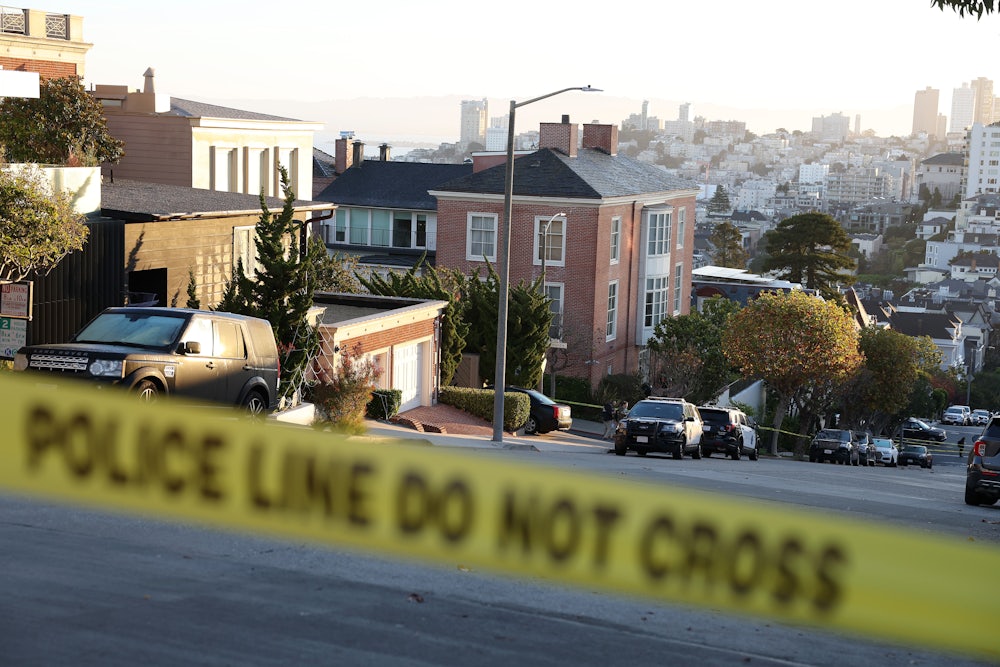“Reasonable” Republicans like New Hampshire Governor Chris Sununu say America has a problem with political violence “on both sides of the aisle.” That isn’t true. America has a problem with political violence against Democrats.
The proof lies in what unreasonable Republicans have been saying since Paul Pelosi, 82, got his skull cracked at 2:30 a.m. Friday morning by a hammer-wielding QAnon enthusiast shouting, “Where is Nancy?” Donald Trump Jr. retweeted a photograph of a hammer and a pair of underwear—an early news report, since corrected, said the attacker was stripped to his underwear—captioned, “Got my Paul Pelosi Halloween costume ready.” Representative Clay Higgins, a Louisiana Republican, posted and then deleted a tweet saying Pelosi’s assailant was a male prostitute whom Pelosi had hired (which of course wasn’t true). Elon Musk, who is not a Republican but appears drawn to the GOP’s more fetid precincts, tweeted along the same lines, later removed the tweet, and still later joked about it rather than apologize. Charlie Kirk suggested the whole story was intended “to smear millions of conservatives.” (For a fuller review of such stomach-turning statements, see Michael Tomasky’s piece, “Paul Pelosi Almost Died, and Most Republicans Don’t Have A Big Problem With That.”)
The GOP has become so extremist that a substantial portion of its leaders and more prominent sympathizers make light of or deny political violence committed against Democrats. There is no corresponding such behavior by leading Democrats when Republicans are threatened or attacked—and yes, there have been some horrific instances—because Democrats don’t count violent insurrectionists as a political constituency they dare not alienate.
The numbers aren’t discussed as often as they should be because most nonpartisan news organizations think it’s bad manners to document their lopsidedness. But let’s get real: “Domestic terrorism” has become a polite euphemism for “right-wing extremism.” The Anti-Defamation League counted 29 people killed in the United States by political extremists in 2021; of those, 26 were killed by right-wing extremists.
This is not a new trend. Indeed, it’s amazing how far back the pattern has held. According to an April 2021 tally by The Washington Post and the Center for Strategic and International Studies, right-wing extremists have since 2015 been involved in 267 plots or attacks and 91 fatalities. The comparable figures for left-wing extremists are 66 and 19. A study released this past summer by the University of Maryland reached back to 1948, thereby capturing the era of left-wing turbulence in the late 1960s and early 1970s—the Weather Underground, the Symbionese Liberation Army, and so on. Yet even this longer timeline showed the likelihood of right-wing violence to be nearly double that of left-wing violence.
“Up against the wall motherfucker” notwithstanding, political violence enjoys much greater social sanction on the right than on the left. Thankfully, it remains true that a majority of Republicans and Democrats reject violence. But nearly three times as many Republicans as Democrats approve of political violence, according to a November 2021 poll by the nonprofit Public Religion Research Institute. Thirty percent of Republicans agreed with the statement, “Because things have gotten so far off track, true American patriots may have to resort to violence in order to save our country.” Incredibly, that view was also shared by 26 percent of evangelicals. Only 11 percent of Democrats agreed. (And yes, that’s 11 percent too many.)
The primary domestic terror threat, according to a June 2022 assessment by the Department of Homeland Security, the FBI, and the National Counterterrorism Center, comes from racially motivated violent extremists “who are driven by a belief in the superiority of the white race” and often “promote accelerationist thinking, which advocates committing violence to precipitate a large-scale conflict, often framed as a ‘race war.’” Since 2010, white supremacists have committed 17 lethal attacks killing 77 people, or slightly more than half the killings attributable to all domestic violent extremists during that period.
You would think Republican politicians would want to distance themselves from the group that poses the greatest domestic terrorist threat. You would be wrong. White supremacy, rebranded “white nationalism,” has been embraced at the party’s highest levels. The Southern Poverty Law Center has documented Trump White House senior policy adviser Stephen Miller’s support for white nationalism. Former Trump White House chief strategist Steve Bannon cited favorably, on multiple occasions, The Camp of the Saints, a notoriously racist 1973 novel in which brown people overthrow Western civilization. President Donald Trump himself famously said in 2017, after a white supremacist named James Alex Fields Jr. killed counterprotester Heather Heyer at a Charlottesville, Virginia, rally organized by white supremacists and neo-Nazis, that there were “very fine people on both sides.” In 2020 Trump declined debate moderator Chris Wallace’s invitation to disassociate himself with white supremacists (“Proud Boys, stand back and stand by”).
Representative Paul Gosar, an Arizona Republican running unopposed this year, keynoted in February 2021 the annual white nationalist America First Political Action Conference and has touted it on Twitter—receiving, incidentally, no reprimand from House Minority Leader Kevin McCarthy. After he sent video greetings to the same event this year Gosar claimed, preposterously, that it was a staff error (“We’re kind of shorthanded, and it was a miscommunication”). Republican Representatives Marjorie Taylor Greene and Steve King appeared in person at this year’s event. This is the political party that has the nerve to run on restoring law and order.
According to the Capitol Police, between 2017 to 2021 the number of threats against sitting members of Congress increased from 3,939 to 9,625. The Capitol Police don’t furnish a breakdown by party, but a New York Times analysis earlier this month of threats that ended in indictments found that more than one-third were made by Republicans or other MAGA types against Democrats, compared to fewer than one-quarter made by Democrats against Republicans. Another telling statistic from the Times analysis was that Democratic members of Congress outspent their Republican colleagues on security by $9,000 on average. Hispanic, Black, Asian American, Pacific Islander, and Native American members outspent their white colleagues by $17,500 on average.
The next wave of violent threats will be directed at volunteers and government officials involved in counting ballots for the 2022 midterms. Predictions that the GOP will win back the House and maybe the Senate don’t seem to deter the MAGA right from believing these elections will be fixed. The threats have begun already. The Justice Department reported in August that it had reviewed more than 1,000 threats against election officials and workers and initiated criminal investigations in 11 percent of these cases. Most of the threats occurred in states where the 2020 results were challenged. A separate study by the Brennan Center found that one in six local election officials have been threatened, either over the phone or in person. Nevada may be the worst. Writing in The Washington Post, Dana Milbank reported that election supervisors in 10 of the state’s 17 counties had either quit, been forced out, or announced their departures, and that the 12-person state elections staff was down to four. This is the fruit of the Capitol insurrection on January 6, 2021, and the GOP’s collective refusal to hold Trump accountable for it.
If election workers are injured or killed in the course of tallying the results on November 8, we may see more hand-wringing about the problem of political violence in America. But it’s a near certainty that this violence won’t emanate from “both sides of the aisle.” It will be from a Republican Party that has lost its mind. Failure to acknowledge this will guarantee that the problem persists.






